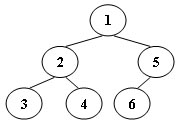题目链接:点击打开链接
7-10 Tree Traversals Again(25 分)
An inorder binary tree traversal can be implemented in a non-recursive way with a stack. For example, suppose that when a 6-node binary tree (with the keys numbered from 1 to 6) is traversed, the stack operations are: push(1); push(2); push(3); pop(); pop(); push(4); pop(); pop(); push(5); push(6); pop(); pop(). Then a unique binary tree (shown in Figure 1) can be generated from this sequence of operations. Your task is to give the postorder traversal sequence of this tree.

Figure 1
Input Specification:
Each input file contains one test case. For each case, the first line contains a positive integer N (≤30) which is the total number of nodes in a tree (and hence the nodes are numbered from 1 to N). Then 2N lines follow, each describes a stack operation in the format: "Push X" where X is the index of the node being pushed onto the stack; or "Pop" meaning to pop one node from the stack.
Output Specification:
For each test case, print the postorder traversal sequence of the corresponding tree in one line. A solution is guaranteed to exist. All the numbers must be separated by exactly one space, and there must be no extra space at the end of the line.
Sample Input:
6
Push 1
Push 2
Push 3
Pop
Pop
Push 4
Pop
Pop
Push 5
Push 6
Pop
Pop
Sample Output:
3 4 2 6 5 1//出栈的顺序其实是中序遍历 输出后序遍历
#include<stdio.h>
#include<string.h>
#include<stack>
using namespace std;
int n;
int pre[35],ld[35],rd[35];
int ans=0;
void dfs(int u)//输出后序遍历
{
if(ld[u]!=-1)
dfs(ld[u]);
if(rd[u]!=-1)
dfs(rd[u]);
if(ans==0)
{
printf("%d",u);
ans=1;
}
else
printf(" %d",u);
}
int main()
{
int i,u,v;
char st[20];
stack<int>s;
while(!s.empty())
{
s.pop();
}
scanf("%d",&n);
scanf("%s",st);
for(i=1;i<=n;i++)
{
pre[i]=i;
ld[i]=rd[i]=-1;
}
if(strcmp(st,"Push")==0)
{
scanf("%d",&u);
pre[u]=0;//根节点
s.push(u);
}
v=u;
int nn=n*2-1;
//printf("%d\n",nn);
while(nn--)
{
scanf("%s",st);
if(strcmp(st,"Push")==0)
{
scanf("%d",&u);
//上一步操作的节点是栈顶元素则放入的是左孩子,否则是右孩子
if(!s.empty()&&v==s.top())
{
pre[u]=v;
ld[v]=u;//左孩子
}
else
{
pre[u]=v;
rd[v]=u;
}
s.push(u);
v=s.top();
}
else
{
v=s.top();
s.pop();
}
}
for(i=1;i<=n;i++)
{
if(pre[i]==0)
{
//dfs(i);
break;
}
}
//printf("%d\n",i);
dfs(i);
printf("\n");
return 0;
}